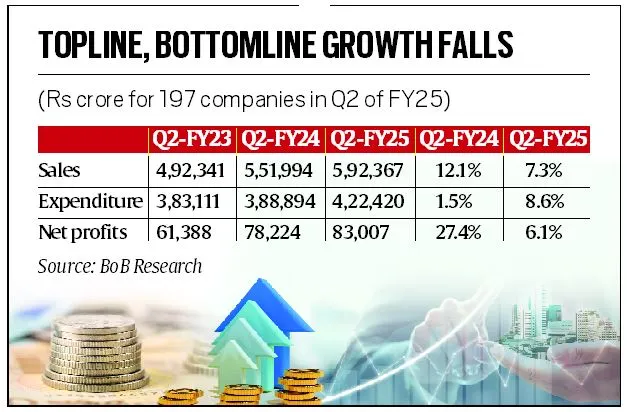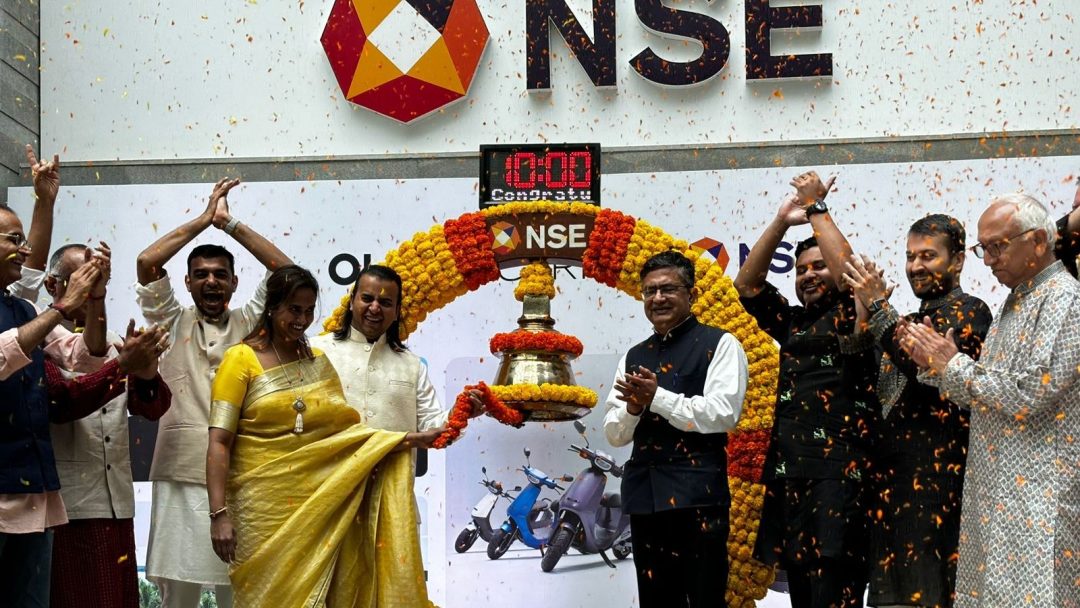The growth rate in net profit of 197 companies declined to 6.1 per cent at Rs 83,007 crore in Q2 of 2024-25 as against 27.4 per cent (Rs 78,224 crore) in the same period of last year, according to data compiled by Bank Baroda Research.

India Inc’s growth rates in revenue and profits have taken a hit if the initial trends from the financial results of listed companies for the quarter ended September 2024 are any indication.
The growth rate in net profit of 197 companies declined to 6.1 per cent at Rs 83,007 crore in Q2 of 2024-25 as against 27.4 per cent (Rs 78,224 crore) in the same period of last year, according to data compiled by Bank Baroda Research.
The decline in profit growth has come in the wake of a rise in expenses and input costs in the second quarter. The picture weakens further if the 10 banks in the sample are excluded. “A higher growth in expenses resulted in low growth at 3.3 per cent in net profits of 187 companies, excluding banks, as against a growth of 23.2 per cent in Q2 of 2023-24. This is indicative of higher input costs to a large extent,” said Madan Sabnavis, Chief Economist, Bank of Baroda.
Sales growth of 197 companies dipped to 7.3 per cent at Rs 592,367 crore in Q2 of 2024-25 as against 12.1 per cent (Rs 551,994 crore) a year ago. However, growth in expenditure (excluding depreciation and interest) is higher at 8.6 per cent compared with 1.5 per cent in Q2-FY23, BoB research report said. Rating firm Crisil said revenue growth of 5-7 per cent for Q2 is likely to be the slowest in the last 16 quarters.
Among leading corporates, Reliance Industries Ltd (RIL), India’s largest firm in terms of market capitalisation, posted a 3.62 per cent decline in net profit at Rs 19,101 crore for the second quarter ended September 2024 as against Rs 19,820 crore in the same period a year ago. Hindustan Unilever Ltd (HUL) reported a 3.86 per cent decline in the standalone net profit at Rs 2,612 crore for the quarter ended September 2024 (Q2) as against Rs 2,717 crore in the same period of last year as the “FMCG demand witnessed a moderating growth”.
“In the September quarter, FMCG demand witnessed moderating growth in urban markets while rural continued to recover gradually,” HUL CEO and Managing Director Rohit Jawa said on Wednesday. TCS reported a rise of five per cent in its net profit to Rs 11,909 crore for the September quarter. “We saw the cautious trends of the last few quarters continue to play out in this quarter as well,” said K Krithivasan, MD and CEO of TCS.
Crisil said India Inc is estimated to have clocked a slower revenue growth of 5-7 per cent on-year for the three months ended September, marking the slowest pace in the past 16 quarters, because of stagnant performance in the construction vertical, which accounts for a fifth of India Inc’s revenue, besides a decline in the industrial commodities vertical and subdued growth in investment-linked sectors.
Crisil study is based on our analysis of 435 companies that account for almost half of the listed market capitalisation. These companies posted 8.3 per cent growth in the April-June quarter.
“Revenue of industrial commodities, investment and construction-linked sectors—collectively accounting for 38 per cent of our sample set—grew only 1 per cent, weighing down overall performance. The industrial commodities sector, such as coal, saw a 6-7 per cent revenue decline due to lower coal offtake, coal-based power generation and e-auction premiums,” said Pushan Sharma, Director- Research, CRISIL Market Intelligence and Analytics.
In the investment sector, the power segment (70 per cent revenue contribution), grew just 1 per cent as above-normal monsoon reduced power demand. Among construction-linked sectors, steel revenue fell 2-3 per cent due to price drop led by cheap Chinese imports, Crisil said.
However, Crisil said India Inc’s profitability is estimated to have improved 70-90 basis points (bps) on-year during the quarter. The overall earnings before interest, tax, depreciation and amortisation (Ebitda) for 435 companies grew 10 per cent on-year.
Among the top 10 sectors, which account for 75 per cent of revenue, eight saw Ebitda margin expansion, led by export-linked sectors such as IT services and pharmaceuticals, investment-linked sectors such as power, and consumer discretionary sectors such as automotive and telecom services. The two sectors that faced margin contraction were steel, due to higher iron ore prices, and cement, due to subdued pricing, Crisil said.
The RBI recently projected a lower GDP growth of 7 per cent for Q2 of FY25 as against 7.2 per cent for the full year. “India’s growth story remains intact as its fundamental drivers – consumption and investment demand – are gaining momentum. Prospects of private consumption, the mainstay of aggregate demand, look bright on the back of improved agricultural outlook and rural demand,” RBI Governor Shaktikanta Das said at the monetary policy review earlier this month.


